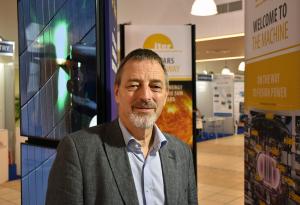Navigating Europe's course
Since 2013, the European Roadmap to Fusion Energy has been the fundamental document guiding European priorities in fusion R&D until the ultimate goal—achieving electricity from fusion energy. On the occasion of the release of version 2.0, Newsline asked EUROfusion Programme Manager Tony Donné about the updated document, the role of ITER, and the overall outlook for fusion energy.
What is the rationale behind the new Roadmap?
The European Fusion Roadmap outlines the research and development required to provide the basis for an electricity-generating fusion power plant. This new version is an evolution, not a revolution. In the first Roadmap we took DEMO (the DEMOnstration power plant) as the end point. We were—and still are—aiming at having electricity from fusion as fast as possible. But we didn't look at how we would get from DEMO to a commercial fusion power plant. Now, the design for DEMO will already include the requirements for a future fusion power plant to ensure an easy adaption.
ITER is the central device and roughly 60-65 percent of the present EUROfusion budget is dedicated to research supporting ITER. Most of the campaigns at the European fusion devices are aimed at supporting the ITER Project. At JET, for example, we are conducting specific ITER-relevant tests like the upcoming deuterium-tritium campaign, the shattered pellet injection testing, and the helium campaign. All of these research activities are part of the Roadmap and contribute to the ITER Project. But also, EUROfusion work at the various national devices is strongly focused on research questions in support of ITER.
DEMO will demonstrate first electricity production to the grid by fusion. The responsibility for the European DEMO lies in essence with Fusion for Energy (F4E), the European Domestic Agency. However, with ITER being the top priority for F4E in the next decade, EUROfusion has been asked to develop the design for DEMO. Taking on this task, we realized that we will have to involve industry from the beginning. Based on experience from various large engineering projects, we believe that the involvement of industry in the pre-conceptual and conceptual design phases will be very advantageous.
An important new element is the involvement of our stakeholders. We have created a stakeholder group with representatives from electricity plants, grid operators as well as representatives from the nuclear and nuclear waste industries. Before fusion energy comes on the market we need to identify the most useful way for fusion power plants to deliver energy for conversion to electricity. We develop this input with our stakeholders to define the requirements for DEMO—it's like a retro-planner for fusion energy.
The collaboration has to be global as the development of fusion energy is of global importance. And it is a big challenge, so we all need to work together to achieve this goal of producing energy from fusion. Naturally, our work with ITER is international in the sense that we collaborate with all ITER Members.
The question really is: do we need fusion electricity? To answer that question I use the example of Germany which is currently subsidizing wind and solar energy concepts with about EUR 25 billion per year. That is roughly equivalent to building one ITER per year. Last year Germany managed to cover 37 percent of its energy consumption from renewables, mostly wind and solar. But, at the same time CO2 emissions from electricity production didn't decrease as fossil fuels such as peat are still being used for the base load.


